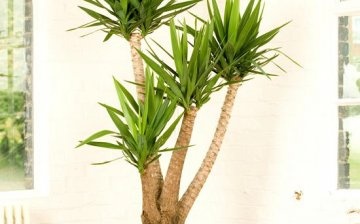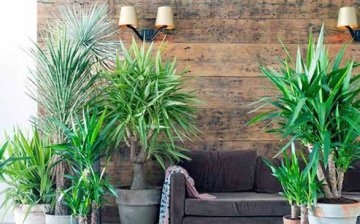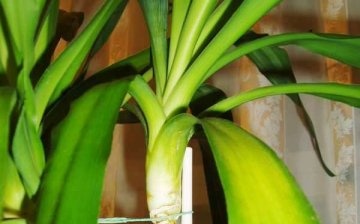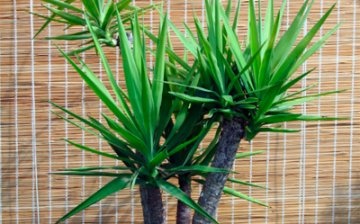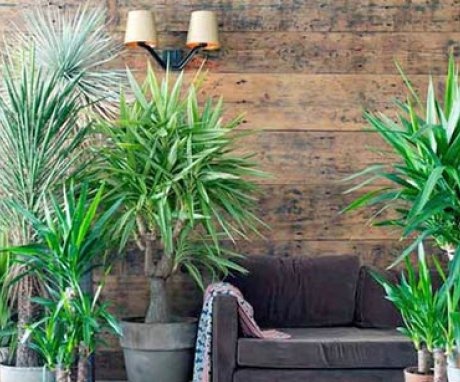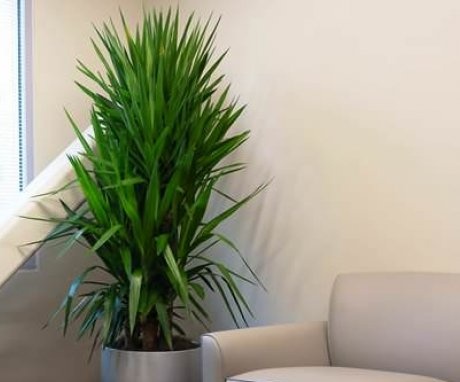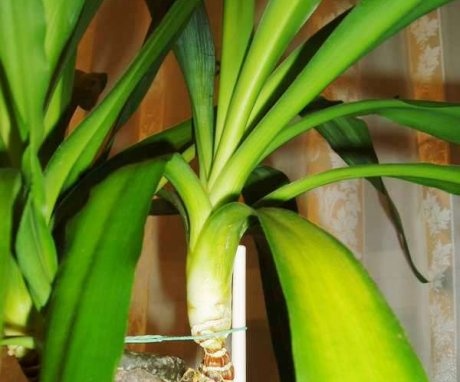Yucca leaves turn yellow: why and what to do?
The numerous agave family includes a resident of the tropics, subtropics - yucca... These evergreen trees can be found not only in premises intended for housing, but also in offices, foyers of institutions, and gardens. Attractiveness of appearance and unpretentiousness in care are the advantages of growing a perennial. But the plant does not pass by the problems either.
This plant is quite famous in the countries of America, especially Mexico. Indian tribes appreciated the quality of the leaves of an evergreen perennial, making clothes, shoes, ropes from them. And headache medicine could be made from plant parts. By applying the sheet to the wound, the bleeding was stopped. This tree of life is adored by animals and insects. In many troubles, yucca helps, and a person must help the plant if it gets sick.
Content::
- Features of the appearance of yucca
- Creating conditions for growing a plant
- Causes of yellowing and drying of leaves in yucca
- Troubleshooting recommendations
Features of the appearance of yucca
In nature, there are more than thirty species of tropical trees. Some of them have a tree-like thick stem, which is covered with brown scales formed as a result of drying of the leaf blades. There are also species that have rosettes from which leaves emerge spreading.
If in the wild the plant reaches ten meters in height, then indoors it does not grow more than two.
The most beautiful part of the yucca is the long, sometimes up to one hundred centimeters, leaves, dense to the touch, with scratching jags along the edges or with a prickly top. In color, they are both dark gray and similar to swamp mud. Looking at the yucca, it seems that the Native American warriors have placed their battle swords, turning the weapon into a plant.
Bloom yucca can be seen when it is covered with paniculate inflorescences in which bells white, cream tones with shades of yellowness, greenery. In their place, fruits are then formed in the form of a fleshy box with black seeds. Common types yucca, growing at home, mostly self-pollinated, which cannot be said about its species in the wild. There, for the ripening of the fruit, the efforts of a miniature butterfly are needed.
Creating conditions for growing a plant
Many newcomers from the tropics live on our windowsills, and they require the same conditions as at home. Yucca is no exception:
- Compliance with the light regime is the main moment in the life of a perennial. But he does not need the burning rays of the sun either. A compromise is needed here: the ideal place is where the yucca meets the first rays of the sun in the east and the sunset in the west of the house. The plant will need up to sixteen hours of daylight per day. In winter, this will only provide additional lighting using fluorescent lamps.
- The temperatures in which the perennial likes to exist range from plus twenty-five in the summer and eight in the winter.
- The soil for the plant is chosen loose, with good permeability to air and water. A layer of expanded clay is spread on the bottom of the pot, which helps prevent moisture from stagnating.
- Since the flower grows in arid regions at home, it is not afraid of dry air.But still, spraying the crown will not interfere: the dust will be washed off the leaves, and the leaves of the tree will be moistened. For the procedure, use soft water, warm to the touch. You can increase the humidity in the room by placing the pot with the plant in a container with pebbles moistened with liquid. And the pebbles need to be moistened periodically.
- Dry topsoil in a pot requires moderate watering... Constant moisturizing without measure will lead to decay root system.
- They begin to feed the yucca in spring after two to three weeks of a break, and mineral, and organic fertilizers... The foliar feeding method by spraying the crown with a nutrient solution is also welcomed.
Creating comfortable conditions for the yucca will allow you to avoid some of the ailments of the perennial.
Causes of yellowing and drying of leaves in yucca
Especially often you can find yucca with yellowed leaves, which indicates several causes of the disease:
- If there is not enough light, which is usually the case in the cold season, then the plant begins to turn yellow and dry.
- In bright sunlight, yucca suffers from burns, which sometimes even lead to the death of a house tree.
- Despite the ability to survive in an arid climate, a flower after a long absence of water will not be able to delight with the beauty of the leaves, they will begin to dry out first from the tips, then completely turn yellow.
- The tips of the leaf plate of the tree curl and turn yellow in the event that sudden temperature changes begin indoors or on the street, the plant is overcome by drafts.
- Frequent untimely transplants lead to minor damage to the roots, to which the tree reacts painfully, starting to wither, turn yellow.
- By deciding to change the location of the yucca, you can cause her negative reaction to this unwanted action.
- Attack on a tree aphids, spider mites, scale insects are manifested by the yellowness of the crown.
Leaves dying at the bottom of the trunk indicate that they are dying off due to their aging. This pattern cannot be eliminated, and it is not necessary. You just need to remove the dried leaves to make room for the new, young.
Troubleshooting recommendations
In accordance with the reasons, the yellowing of yucca leaves is also eliminated:
- By shaping artificial lighting, the daylight hours are lengthening. Diffuse light on cloudy days can eliminate the yellowness of the leaves.
- To avoid sunburn, the yucca leaves should be shaded with sheets of paper.
- IN watering moderation must be observed. Better to let the soil dry out a little than become waterlogged.
- A moderate temperature regime is also comfortable for a perennial.
- Before rearranging the container with a tree to another place, you need to see if it will be as good for it as in the previous one. Even when moving, it is better to choose the same living conditions for the yucca as in the previous apartment.
- It is necessary to fight flower pests immediately when they are detected. Delaying treatment will lead to the death of the pet. To combat pests, you need to find an effective remedy. Aphids can be destroyed by spraying the crown of the tree with soapy water and vegetable oil.
- For preventive purposes, you can remove five centimeters of the earth, replacing it with a new layer. This will prevent spider mites from becoming infected. Spraying with Aktofit is also effective.
- It is recommended to scrape off the leaves by hand, and remove the damaged parts of the plant. A high number of larvae can be destroyed by spraying with a solution of laundry soap (200 grams per bucket of water) with the addition of soda ash (20 grams).
- In the fight against pests, spraying with Fitoverm, Aktellik is also used.
Treating a house and garden plant with care, you can always ensure that it will be healthy, developing normally. Several types yucca known to gardeners, as they grow in the premises of the house, and in garden plots.This tropical plant is interesting in its external qualities, it has a lot of medicinal properties.
More information can be found in the video:



